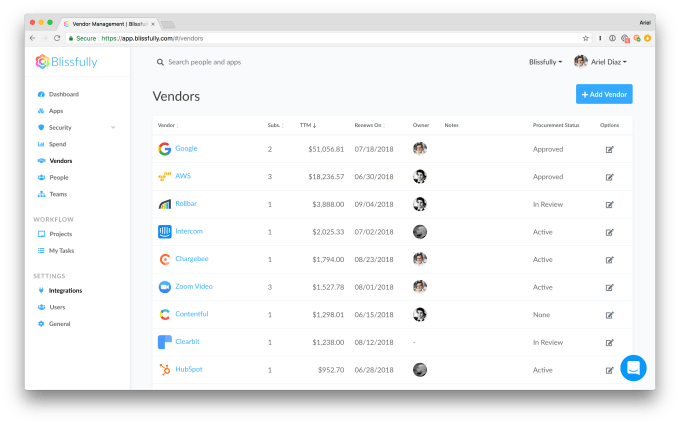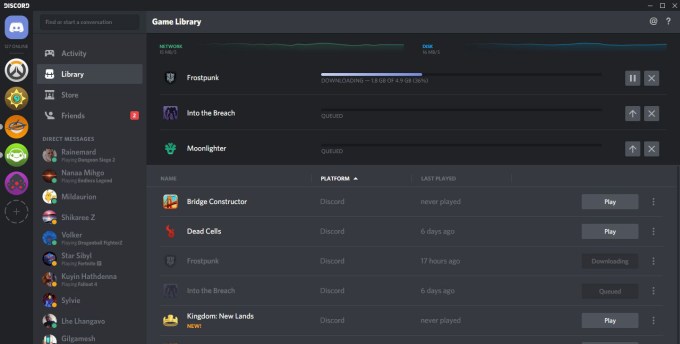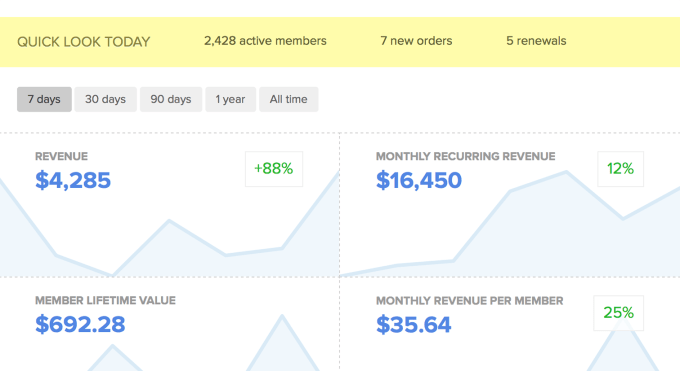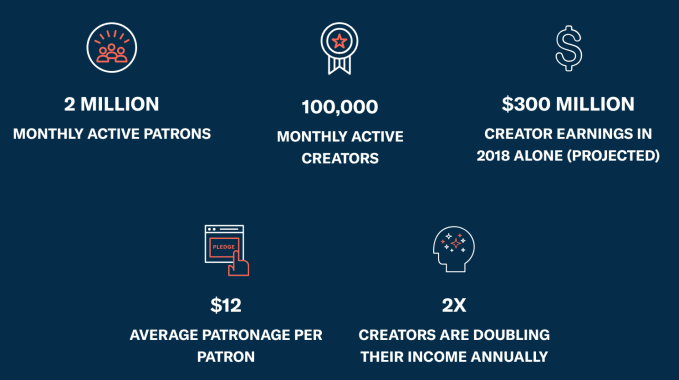TC
Auto Added by WPeMatico
Auto Added by WPeMatico
Blissfully, a New York City startup that helps companies understand their SaaS usage inside their organizations, announced it has received a $3.5 million seed round.
The investment was led by Hummer Winblad Venture Partners. Hubspot, Founder Collective, and several unnamed pre-seed investors also participated. They got a $1.5 million pre-seed investment, bringing the total so far to $5 million, according the company.
Company co-founder and CEO Ariel Diaz says Blissfully actually helped him and his co-founder solve a problem they were having tracking the SaaS usage at their previous startups. Like many companies, they were using spreadsheets to track this information and they found it was untenable as the company grew beyond 30 or 40 people. They figured there had to be a better way, so they built one.
Their product is much more than simply a database of the SaaS products in use inside an organization. It can integrate with existing company systems like single sign-on tools such as Okta and OneLogIn, financial reporting systems and G Suite login information. “We are trying to automate as much of the data collection as possible to discover what you’re using, who’s using it and how much you are spending,” he said.

Blissfully SaaS report. Screenshot: Blissfully
Their scans often turn up products customers thought they had canceled or those that IT had asked employees to stop using. More than finding Shadow IT, the product also gives insight to overall SaaS spend, which many companies have trouble getting a grip on. They can find most usage with a scan. Some data such as customized contract information may have to be manually entered into the system, he says.
Hubspot CEO Brian Halligan, whose company is one of the investors in this round, sees a growing need for this kind of tool. “The widespread growth of SaaS across companies of all sizes is a leading indicator of the market need for Blissfully. As business’ investments in SaaS increase, they lose visibility into issues ranging from spending to security,” Halligan said in a statement.
The company offers a freemium and pay model and is available in the G Suite Marketplace. If you go for the free version, you can scan your systems for SaaS usage, but if you want to do more complex integrations with company systems, you have to pay. They currently have 10 employees and 500 customers with a mix of paying and free.
One interesting aspect of the Blissfully tool is that it is built entirely using Serverless architecture on AWS Lambda.
Powered by WPeMatico
It’s true, Fortnite is coming to Android this summer. We’ve known that for sure since May. There is, however, one key caveat (aside from that whole no Google Play bit): The obscenely popular sandbox survival game will launch on Google’s mobile OS as a Samsung exclusive.
The Epic title will be available for Galaxy users with an S7 or higher (Note 9, S9, Note 8, S8, S7,S7 Edge). Those with a Galaxy Tab S4 and S3 will get a crack it it, as well). That, naturally, includes the new Note 9, which the company is positioning as something of a mobile gaming powerhouse.
The specs are certainly impressive, and the 6.4-inch screen should lend itself well to portable gaming. There’s also a new Water Carbon Cooling system on board, to help keep the handset from overheating from more resource-intensive tasks. The new tech improves the liquid cooling system the company has had on-board its Galaxy devices since the S7.

Starting today, the title will appear on Galaxy devices’ game launcher, remaining an Android exclusive until the 12th — at which point, one imagines, it will become more widely available for the rest of Android users. As with the rest of the versions of the title (the PS4’s issues aside), the game will support multi-platform crossplay.
To celebrate the deal, those who pre-order the Note 9 will be able to choose between free AKG noise cancelling headphones or a device with a 15,000 V-bucks — the in-game equivalent to to $150 of our regular people dollars. All Note 9 and Tab S4 users will also get access to a Fortnite Galaxy skin (see: above), which is unique to those devices.
Powered by WPeMatico
Remember the scene in Minority Report where Tom Cruz walks through the mall and thousands of holographic ads pop up around him? That reality may not be as far off as we thought.
Blippar, the augmented reality startup that launched back in 2011, is today announcing the launch of a new product that would let retailers, airports, commercial real estate owners, etc. place augmented reality content across their space.
The product is called the Blippar Visual Positioning System, and it uses computer vision and augmented reality to help customers, tenants, etc. find their way through a large indoor space such as a grocery store, department store, or stadium.
This isn’t Blippar’s foray into AR navigation. The company launched the AR City app in the summer of 2017, which uses the camera of the phone to pinpoint a user’s location with better accuracy than GPS, according to the company. Blippar rolled out functionality for AR City in more than 300 cities.
But the visual positioning system should prove more lucrative. Location services is one critical piece of our digital lifestyle that hasn’t been completely overwhelmed by advertisements. But it’s not hard to imagine advertisements popping up within a department store or sports stadium as a user looks for the beauty department or the closest hotdog, respectively of course.
Blippar sees an opportunity to use this for retail and shopping, entertainment and gamification, tourism, and even design, giving interior designers a chance to check out AR furniture, paint colors, etc.
But there’s also a huge play here around data. Facebook may know just about everything about you, but the advertising behemoth hasn’t made the most of leveraging a user’s location. Blippar might stand a chance at doing just that with the new visual positioning system, giving retailers unprecedented information around the way that customers move through a store.
Because the system uses computer vision to determine a user’s location, the product can be used in offline mode.
Blippar uses blueprints, photography, and 3D models of buildings to build out the visual positioning system, and can turn around the project almost immediately if they have access to CAD files of the building’s layout. Adding content, however, takes as long as designers and other project leaders need to figure out what that content should be and how it should look.
Blippar has been through a number of evolutions as a company. The startup first launched as a tool for brands and publishers, laying AR content on top of real-world objects that were tagged with a Blipp (a little sticker to trigger the AR content).
The company then moved into visual search, letting users point their phone at a car or a flower and learning more about what that real-world object is.
That has all laid the foundation for this latest B2B iteration around navigation. Blippar hasn’t yet disclosed the exact cost of using this new product, but did say that it will range between $300K and $1 million. Thus far, the company has signed on two major clients, one retailer and one commercial real estate owner, though Blippar didn’t disclose which companies it’s working with.
Blippar has raised more than $100 million since launch.
Powered by WPeMatico
Just a few weeks back, Valve moved into Discord’s turf a bit with a dramatic overhaul of Steam’s chat system.
Today, Discord is returning the favor by playing with the idea of selling games through its namesake chat platform.
The company says it’ll launch a beta of the game store later today, though it’ll initially be limited to a small slice of its user base (which now sits at 150 million users). More specifically, the beta will roll out to just 50,000 users from Canada at first.
It’ll be dabbling in game sales on two fronts: they’ll directly sell some games, while other games will be added perks for its Discord Nitro subscription service.
Whereas Valve has massively increased the number of games on Steam over the last few years by opening up to third parties through things like Steam Greenlight or (more recently) Steam Direct, Discord is pitching this as a more “curated” offering with a slimmer number of options. At least at first, they say they’re aiming for something that feels more like “one of those cozy neighborhood book shops” — which, on day one of the beta, translates to 11 games.
The games it’ll sell first:
While 11 games may not seem like much, you can bet they’ll offer more than that in time. See that screenshot up top? You don’t dedicate an entire tab in some of your app’s most prime screen real estate unless you’re hoping to make it a key part of your business.

Taking things one more step forward, Discord is also getting into (temporary) exclusives — or, as it calls them, “First on Discord” games. While it doesn’t mention names and none will roll out with today’s beta, Discord says it’ll soon highlight select indie games that’ll be available only on Discord for the first 90 days-or-so after their respective launches.
Meanwhile, the company is also testing the idea of building up its premium subscription add-on, Discord Nitro, into a game subscription service. Whereas the $5-per-month service previously primarily got you a few mostly aesthetic perks like animated avatars, a special profile badge and bigger upload limits, the same 50,000 players mentioned above (or, at least, those on Windows) will get access to a rotating set of games.
The first games hitting the subscription beta:
While many of those games aren’t exactly new (some of them are 5+ years old), a lot of them are really great games (I’ve lost days to Super Meat Boy) that not everyone has gotten around to playing. It’s a solid way to pique people’s interest in giving Discord a bit of money each month if the GIFs and badges weren’t quite enough.
Oh, and for good measure, Discord is making itself a launcher — that is, you’ll be able to sort and launch most of the games on your computer right from Discord, including games purchased elsewhere and even those, notes the company, that require another launcher to run. If that’s not a shot across the bow in Steam’s direction, I’m not sure what is.

Powered by WPeMatico
Hinge Health, the San Francisco-based startup that offers a tech-enabled platform to treat musculoskeletal (MSK) disorders — things like knee pain, shoulder pain, or back pain — has raised $26 million in Series B funding.
Leading the round is Insight Venture Partners, with participation from the company’s Series A backer Atomico. In fact, I understand that the London VC firm has doubled down on its investment and has actually increased its stake in Hinge.
The new round of funding brings total raised by the company to $36 million since being founded in 2015 (and originally based in London). Hinge Health founders Daniel Perez and Gabriel Mecklenburg still maintain majority control of the board.
Billing itself as digitising healthcare, Hinge Health combines wearable sensors, an app, and health coaching to remotely deliver physical therapy and behavioural health for chronic conditions. The basic premise is that there is plenty of existing research to show how best to treat MSK disorders, but existing healthcare systems don’t do a very good job at delivering best practice, either because of cost and the way it is funded or for other systematic reasons. The result is an over tendency to fall back on the use of opioid-based painkillers or surgery, with sub-optimal results.
The startup’s initial target customers are self-insured employers and health plans, with the pitch being that its platform can significantly reduce medical costs associated with chronic MSK conditions.
To that end, Perez tells me Hinge Health now has 40 enterprise customers in the U.S. and has partnered with 10 of the largest health plans. This is off the back of improved results, with 2 in 3 patients who go through the program avoiding the need for surgery, up from 1 in 2 at the time of the startup’s Series A. “[We’re] aiming to bump that to 80 percent soon,” he says.
Just don’t call Hinge a “software as a drug” or so-called digital therapeutic. Perez isn’t a fan of either term, and certainly not when applied to the work Hinge Health is doing.
“Both seem to imply you just pop one easy pill and that’s it,” he says. “While software, connected hardware, and behavioural health support (e.g. education, coaching, targeted notifications, gamification/rewards) can help scale the labor intensive processes involved in chronic care, it’s not akin to just popping a pill and you’re done. That’s why I really dislike the term “digital therapeutic” when applied to chronic conditions, and I wish it was retired”.
Instead, Perez considers Hinge Health to be a “Digital Care Pathway” as patients are still required to carry out a lot of work in order to tackle their chronic condition. In other words, it goes well beyond just passively popping a “digital pill”.
I ask the Hinge Health founder if perhaps it is access to a one-to-one health coach via the app that makes all the difference, especially related to adherence, rather than technology. That depends, he says, revealing that some patients rely very heavily on having access to a coach, while others need very little or zero coaching support, and instead rely on Hinge’s wearable motion sensors to guide them through their exercises and to track progress.
Adds Perez: “The clinical literature is very compelling; when you have a relationship with a real person on the care team, it boosts adherence to the care plan. Critically that person doesn’t have to be a doctor or even a nurse, but it must be someone you trust”.
Powered by WPeMatico
Taxfix, the Berlin-based startup that has developed a mobile assistant to help you file your tax return, has closed $13 million in Series A funding. The round is led by Peter Thiel’s Valar Ventures, with participation from existing investors Creandum and Redalpine.
Launched in 2017, Taxfix is built on the premise that filing taxes remains a daunting task in most countries, involving a lot of archaic form filling, often carried out incorrectly and without the proper advice, and rarely optimised for tax refunds. As a result, the company says that in Germany alone, over 10 million employees decide not to file a tax return, and therefore forgo an average tax rebate of 935 Euros.
“The problem is that most people don’t have a personal tax accountant, nor the sufficient knowledge on how to file their taxes,” explains Taxfix co-founder and CEO Mathis Büchi. “Taxpayers are required to invest a substantial amount of time to become an expert themselves to receive their maximum tax refund. That’s why the rich can optimise their taxes with their own accountants and the regular citizens are overpaying billions of Euros in taxes every year in almost every country in the world”.
To help combat this, the Taxfix app works similar to a chatbot, and — coupled with the startup’s “tax-engine technology” — aims to make filing your taxes as easy as it would be if you hired your own tax accountant. You simply photograph your annual payslip and work through a questionnaire personally tailored to optimise your refund. The Taxfix app then automatically calculates the predicted tax rebate and submits your filing for you.
“[Taxfix creates] a digital tax accountant on the mobile phone, which asks the users simple questions and makes sure they optimise their refund and file their tax return correctly,” says Büchi.
To date, Taxfix’s typical customers are young people between 20-35 years old, who are not tax experts and often have never filed a tax return before. For every tax return that generates a refund of over 50 Euros, the startup charges 35 Euros for submission to the relevant financial authorities.
Of course, there are already a large number of startups and software companies that can help you file a tax return. These include legacy players such as WISO in Germany and Intuit’s TurboTax in the U.S., or upstarts such as the U.K.’s TaxScouts. A government’s own online tax filing gateway could also be considered a direct competitor.
“Taxfix differentiates itself from all other solutions by its mobile-first approach and by not using forms fields as the user interface,” adds Büchi. “Taxfix creates a completely new user experience with the conversational interface that asks simple questions and translates the information into tax language automatically. It takes on average 20 minutes to file your taxes with Taxfix, compared to 3 to 6 hours with traditional software”.
Meanwhile, Büchi says the new funding will be used for international expansion, bringing the app’s tax declaration capabilities to other jurisdictions. The German company also plans to invest heavily in machine learning to bring its tax engine technology “to the next level”.
Powered by WPeMatico
If you’re a fan of retro games, chances are you have a few emulators installed to let you play Mega Drive or Atari 800 titles. And if you have a few emulators installed, you probably have some ROMs. And if you have some ROMs, it’s likely that sometime since the year 2000 you visited EmuParadise, a stalwart provider of these ambiguously legal files. Well, EmuParadise is no more — at least the site we knew and loved.
The site explained the bad news in a post today, acknowledging the reality that the world of retro gaming has changed irrevocably and a site like EmuParadise simply can’t continue to exist even semi-legally. So they’re removing all ROM downloads.
For those not familiar with this scene, emulators let you play games from classic consoles that might otherwise be difficult, expensive or even impossible to find in the wild. ROMs, which contain the actual game data (and are often remarkably small — NES games are smaller than the image above), are questionably legal and have existed in a sort of grey area for years. But there’s no question that this software has been invaluable to gamers.
“I started EmuParadise 18 years ago because I never got to play many of these amazing retro games while growing up in India and I wanted other people to be able to experience them,” wrote the site’s founder, MasJ. “Through the years I’ve worked tirelessly with the rest of the EmuParadise team to ensure that everyone could get their fix of retro gaming. We’ve received thousands of emails from people telling us how happy they’ve been to rediscover and even share their childhood with the next generations in their families.”
But the games industry is changing; official re-releases of old games and the consequent legal attention that brings to sites hosting original ROMs has created an unambiguously hostile environment for them. Nintendo, it must be said, has been particularly zealous in its efforts to clear the web of ROMs, especially for its first-party games.
EmuParadise and other sites have been the constant target of legal actions, from simple takedown requests to more serious allegations and lawsuits.
“It’s not worth it for us to risk potentially disastrous consequences. I cannot in good conscience risk the futures of our team members who have contributed to the site through the years,” MasJ continued. “We run EmuParadise for the love of retro games and for you to be able to revisit those good times. Unfortunately, it’s not possible right now to do so in a way that makes everyone happy and keeps us out of trouble.
“This is an extremely emotional decision for me after running this site for so many years. But I believe it is the right thing for us at this point of time.”

Alas, they will be unavailable forever now.
I can remember EmuParadise being one of the most reliable sites to get ROMs from back in the day; and in the early 2000s, when emulators were essentially the only way to play many old games — and the web was a bit more wild — it was also one of the few that didn’t attempt to load some kind of virus onto your computer at the same time.
It’s always sad when a homegrown site that single-mindedly pursues a single goal, and in this case one that is arguably a public service, legal or no, is forced to bow out. It’s sad, but they can at least retire knowing that retro gaming is alive and well and finally being embraced by game distributors and makers the way it ought to have been for the last couple decades. Consoles like the NES Classic are outselling modern ones, and love for old games has not abated.
Not only that, but websites like this, while they provide other services, are no longer necessary for the distribution of ROMs. What was practical in 2002 no longer makes sense, and the advent of both legal game stores on PCs and consoles, and of course torrents, mean that even rare games like Radiant Silvergun are just a click or button press away.
And lastly, EmuParadise isn’t just plain dying. They plan to maintain and update their emulator database and keep the community going, and MasJ says there are plans to launch some new things as well. So, out with the old, in with the new.
Thanks to EmuParadise and those running it for all their hard work, and best of luck in the future!
Powered by WPeMatico
Audius wants to cut the middlemen out of music streaming so artists get paid their fair share. Coming out of stealth today led by serial entrepreneur and DJ Ranidu Lankage, Audius is building a blockchain-based alternative to Spotify or SoundCloud.
Users will pay for Audius tokens or earn them by listening to ads. Their wallet will then pay out a fraction of a cent per song to stream from decentralized storage across the network, with artists receiving roughly 85 percent — compared to roughly 70 percent on the leading streaming apps. The rest goes to compensating whomever is hosting that song, as well as developers of listening software clients, one of which will be built by Audius.
Audius plans to launch its open-sourced product in beta later this year. But it’s already found some powerful investors that see SoundCloud as vulnerable to the cryptocurrency revolution. Audius has raised a $5.5 million Series A led by General Catalyst and Lightspeed, with participation from Kleiner Perkins, Pantera Capital, 122West and Ascolta Ventures. They’re betting that Audius’ token will grow in value, making the stockpile it keeps worth a fortune. It could then sell chunks of its tokens to earn revenue instead of charging artists directly.

Audius co-founders (from left): head of product Forrest Browning, CEO Ranidu Lankage, CTO Roneil Rumburg
“The biggest problem in the music industry is that streaming is taking off and artists aren’t necessarily earning a lot of money. And it can take three months, or up to 18 months for unsigned artists, to get paid for streams,” says Lankage. “That’s what crypto really solves. You can pay artists in near real-time and make it fully transparent.”
The big question will be whether Audius can use the token economy to crack the chicken-and-egg problem of getting its first creators and listeners on a platform that might be less functionally robust than its traditional competitors. There are a lot of moving parts to decentralize, but there are also plenty of disgruntled musicians out there waiting for something better.
Most startup guys don’t have Billboard charting singles on their bio, but Lankage does. Born in Sri Lanka, his hip-hop songs in his native tongue of Sinhalese were the first of the language to be played on the BBC and MTV. He got signed to Sony and even went platinum, but left the label seeking greater control over his work. After going to Yale, he applied his music business knowledge to build a Reddit for dance music called The Drop with Twitch’s Justin Kan back in 2015.
The two teamed up again on a video version of Q&A app Quora called Whale, but that fizzled out too. Lankage’s next venture Polly, a polling tool built as a complement to Snapchat, inspired the now super-popular Instagram Stories polls and questions stickers. But after an acqui-hire by Reddit fell through, he returned to his first love: music.
“I’ve always been passionate about building tools for creators,” says Lankage. But this time, he wanted to focus on helping them turn their art into a profession. He teamed up with CTO Roneil Rumburg, an engineering partner at Kleiner Perkins who’d build a crypto wallet called Backslash, and head of product Forrest Browning, who’d sold his software metering startup StacksWare to Avi Networks.
Their goal is to build a blockchain streaming music service where listeners don’t have to understand blockchains. “A user wouldn’t even know that they have a wallet,” says Rumburg. They’ll just hear an ad every once in a while, get a subscription, or pay per stream. Since Audius is open sourced, developers will be able to build their own listening clients on top, which could specialize in discovery of certain types of music or offer their own payment schemes.

“I have known Ranidu, Forrest and Roneil for a long time, and have always been impressed with their ability to blend art, technology and business together,” says investor Niko Bonatsos of General Catalyst. “In Audius, they bring together all three skills, with a deep technical heart and a compelling solution for a very big marketplace.”
For starters, Audius is focusing on signing up independent electronic musicians. These are the types that might be popular on SoundCloud but actually have to pay for hosting there while not getting much back due to the platform’s weak monetization options. Don’t expect U2 and Ariana Grande on Audius, at least not yet. But the startup could differentiate by offering access to content you can’t find elsewhere.
To get artists on board, Lankage tells me Audius plans “to use token incentives.” Those willing to jump on first before there are many listeners could get a bonus allotment of tokens that might be worth more if they help popularize the service. And where artists go, their fans will follow. Audius is hoping artists will share its links first because that’s where they’ll earn the most money.
 Audius has also lined up a legion of big-name advisors to help it develop its blockchain product and artist relationships. Those include Augur co-founder Jeremy Gardner, EDM artist 3LAU, EA co-founder Bing Gordon and more it can’t announce just yet.
Audius has also lined up a legion of big-name advisors to help it develop its blockchain product and artist relationships. Those include Augur co-founder Jeremy Gardner, EDM artist 3LAU, EA co-founder Bing Gordon and more it can’t announce just yet.
The linchpin of Audius will be the user experience. If the system feels too complicated, listeners and artists will stay elsewhere. A DJ might earn more per stream from Audius, but if Spotify or SoundCloud offer better ways for fans to subscribe to them and generate more plays long-term, they’ll still direct supporters there. But if Audius can hide the nerdy bits while solving the music industry’s problems, it has the potential to be one of the first mainstream consumer blockchain projects that treats the tech as a utility, not just a new stock market to bet on.
Powered by WPeMatico
Patreon is forming a patronage empire. Today it acquired white-labeled subscription membership platform Memberful, which lets creators sell exclusive access to content through their own site instead of a centralized platform like Patreon. Rather than being folded into a Patreon feature, Memberful will run as an independent brand, maintaining its tiered pricing structure, though new sign-ups will get a rate closer to Patreon’s low 5 percent rake.
Terms weren’t disclosed for the deal that brings Memberful’s whole seven-person team and 500 paying clients aboard. But Patreon clearly sees rolling up competitors and complements in the patronage space as a worthy use of its $60 million raise at a $450 million valuation late last year that brought it to $105 million in funding. In June, Patreon bought Kit to let creators bundle in merchandise with their perks for paying monthly subscribers. It also bought out competitor Subbable back in 2015.

By teaming up, Patreon and Memberful will be able to provide subscription patronage services for creators, whether they want their fan community to live on Patreon, or through Memberful on their own WordPress or website with integrations of Stripe and MailChimp. Patreon already has 2 million patrons paying an average of $12 each to a total of 100,000 creators, and it expects to pay out $300 million in 2018 alone. The acquisition could let Patreon move up market, recruiting comedians, illustrators, game developers and vloggers that already have an established audience elsewhere.
“I think membership is on the up and is going to grow for the next decade,” says Patreon VP of Product Wyatt Jenkins. “Our strategy is to be an open, neutral platform,” as opposed to focusing on one type of content like YouTube with videos or Twitch with streaming where you’re locked into that platform’s tools. Memberful, launched in 2013, has bootstrapped the creation of its white-labeled tools without the need for venture funding.

Memberful gives creators like Stratechery’s Ben Thompson (who has an interview with Patreon CEO Jack Conte about the acquisition) and podcast producer Gimlet Media full control over branding, with no Patreon chrome. But it’s more expensive and also requires more work as creators have to manage their own site, customer service and payment processing. Memberful takes a 10 percent cut with no monthly fee for its limited basic tier, or $25 per month plus 4.9 percent for the full-featured pro version, though it also offers enterprise pricing. That pricing will remain for existing users, but “new customers will see a transaction fee closer to Patreon’s,” which is a flat 5 percent, a Patreon spokesperson tells me. Patreon does basically everything for a creator, but it also ropes them into the Patreon-branded ecosystem that also promotes other content makers.
Sometimes Patreon handling everything can be a problem, though. Last week it experienced a higher-than-normal volume of declines from banks of charges to patrons. That left some creators without their expected income, and required patrons to deal with the chore of calling their bank to tell them paying $1, $5 or $20 per month to their favorite creator wasn’t fraud. Patreon now tells me that “as of Friday, we let everyone know that we were back to normal decline rates, and were going to continue retrying the rest of the cards like we normally do.”

It makes sense for Patreon to race to consolidate the patronage industry as it’s being invaded by giant incumbents. Twitch, YouTube and Facebook all offer their own versions of paid subscriptions to creators that get patrons extra perks like exclusive content or badges so they stick out in chat rooms full of fans. While those platforms are all focused on video streamers, they still pose a threat to Patreon, which needs to maximize the number of successful creators it hosts in order to earn enough from its tiny cut of payments. Facebook especially could muscle in, as many creators already run their own Facebook Pages.
Asked about competition from those platforms, Jenkins said, “I think there’s a strong chance it’s a tailwind. The concept of membership is pretty new. If those big companies are going to drop millions of dollars into marketing the concept of membership I think that’s great.” He stressed the question of “Do you want to own your fan base? On YouTube, those aren’t your fans, they’re YouTube users. YouTube is incentivized to keep them watching videos so it can show ads.”
That might lead fans to unsubscribe from a creator as YouTube promotes other similar ones they could watch instead. “You don’t own the relationship.” Facebook Page admins have found that out the hard way as algorithm changes prioritize friends over public figures, making it tough to reach the followers they spent years begging to like them. If Patreon can offer creators audience growth through discovery on its interconnected network without cannibalizing anyone’s member counts, its neutrality and focus could make it a leader in this new wing of the digital economy.
Powered by WPeMatico
H1Z1 has spent a couple months on PS4 in an open beta. But today, the Battle Royale game is officially making its debut on the PlayStation platform.
Much like Fortnite Battle Royale, which has swept the gaming world unlike almost any title before it, H1Z1 drops 100 players into a map where they must loot up and survive. Unlike Battle Royale, H1Z1 is relatively more realistic, with a much larger map, more drab colors, and a handful of drivable vehicles.
Interestingly, H1Z1 was one of the earlier Battle Royale games during the game type’s wave of popularity, catching the attention of pro gamers back in 2015. Back then, the game was only available via Steam.
Since, games like PUBG and Fortnite have grown wildly, forcing H1Z1 makers Daybreak to play a bit of catch up.
But today, H1Z1 goes officially live on the PS4, giving gamers who are sick of Fortnite’s bubbly world a chance to get into the Battle Royale world in a different way.
Plus, Daybreak has added in a Fortnite-style Battle Pass for the season, letting PS4 players unlock reward levels for $5.49. H1Z1 is also getting a couple new weapons, including a Sniper Rifle and an RPG, as well as an ARV that can fit a full team of five.
You can check out the launch trailer below:
Powered by WPeMatico